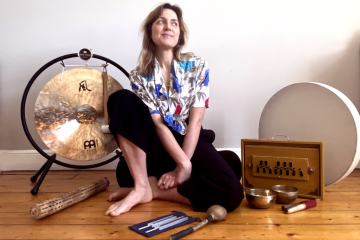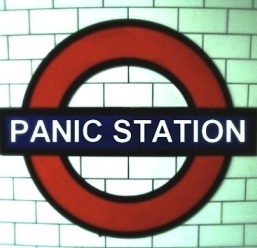by Meaghan Delahunt
Connections: Yoga for Bhopal
I was in India in 2000, a place I had always wanted to visit. I was there for three months on a UNESCO International Literature fellowship. I was writing my second novel, The Red Book, which at the time I thought of as my ‘yoga’ novel. As usual, when writing a novel or a short story, I didn’t start with a plot or a plan but rather an image, a colour, a line. It’s always an intuitive process.
Shortly before I left Edinburgh I had a dream which involved the colour red, a Buddhist monk and the city of Bhopal. A child hovered at the edge of the dream. I took these images as a sign. On the day I arrived at Sanskriti Kendra – the artists’ ashram outside Delhi which was my base - the first person I met was a young Muslim man from Bhopal. We became good friends and he said, ‘You must stay with my family.’ That’s how I came to visit Bhopal several times and how I first made my way to the Sambhavna clinic. This clinic in Old Bhopal was pioneering Yoga therapy and Ayurvedic medicine in the treatment of the gas-affected population.
I’d followed events in Bhopal closely since the gas disaster at the Union Carbide factory in 1984. I’d been involved in left-wing politics in my youth in Australia and the whole Bhopal tragedy had a big impact on me. I kept thinking, how could such a thing happen? A gas leak from a chemical factory in which the safety systems had been turned off? If Indian lives had not been seen as more expendable than Western lives, if poor people had not been living in the lee of the chemical plant, if Union Carbide had not put profit before people, this would never have happened.
Bhopal 1984
Over 10,000 died on the night of the gas, half a million were exposed to the toxins and at least 25,000 have died subsequently. High rates of cancer, pulmonary and gynaecological illness are the norm in Bhopal. The water table surrounding the plant is contaminated and Union Carbide (merged with Dow Chemical, now DuPont) still refuse to clean up the site or to pay adequate compensation to the survivors. The corporate takeovers attempt to hide any corporate responsibility.
In 1984, I remember seeing the famous Raghu Rai photograph of the dead Bhopali child half-buried in the dirt. That image still haunts me and it became a touchstone for The Red Book. Bhopal and its aftermath brings together east and west: environmental issues; women’s issues; health issues. In short it brings together politics, spirituality and yoga.
The Work of the Sambhavna Clinic
In 2002, I was back in India for another three months, on another literature residency, this time with Asialink. Again, I paid visits to Bhopal. Almost 18 years ago the Sambhavna clinic was much smaller than it is today. It offered free health care to the people of Bhopal. It offered Western medicine, Yoga Therapy and Ayurveda. There was a small specialist gynaecological clinic donated by French writer Dominic Lapierre. Sambhavna was seriously impressive and the dedication of volunteers and paid workers very moving to witness. Today, as a result of international fundraising efforts, Sambhavna clinic has bigger premises and a large herb garden to provide Ayurvedic medicine. I would love to go back. Over the years, various scientific studies have proven how effective both Yoga & Ayurveda have been for the gas-affected population – particularly women.
 I remember being at Sambhavna and thinking, all those years ago, that not only would I write about Bhopal in both fiction and non-fiction - but that one day in the future when I became a yoga teacher, I would do something to raise funds for the clinic.
I remember being at Sambhavna and thinking, all those years ago, that not only would I write about Bhopal in both fiction and non-fiction - but that one day in the future when I became a yoga teacher, I would do something to raise funds for the clinic.
Yoga for Bhopal is the result.
This year we have a whole day at Santosa in Edinburgh on Dec 3rd and other Yoga centres in Leeds, York and Sheffield have joined in. I hope this work will spread as part of a world-wide effort to celebrate the work of the Sambhavna clinic and to draw attention to the ongoing situation in Bhopal.
Our work on the mat helps create a better world off the mat.
Look forward to seeing you there.
Facebook: YogaforBhopal
©Meaghan Delahunt 2/11/17
 MEAGHAN DELAHUNT is a novelist and short story writer. Her work has been widely translated and her stories anthologised and broadcast on BBC Radio 4. In 1997 she won the Flamingo/HQ National Short Story Prize in Australia. Awards for her novels In the Blue House (Bloomsbury, 2001), The Red Book (Granta, 2008) and To the Island (Granta, 2011) include a regional Commonwealth Prize, a Saltire Award and a nomination for the Orange Prize. From 2004-2013 she worked as a Lecturer in Creative Writing at St. Andrews University and at the University of Stirling.
MEAGHAN DELAHUNT is a novelist and short story writer. Her work has been widely translated and her stories anthologised and broadcast on BBC Radio 4. In 1997 she won the Flamingo/HQ National Short Story Prize in Australia. Awards for her novels In the Blue House (Bloomsbury, 2001), The Red Book (Granta, 2008) and To the Island (Granta, 2011) include a regional Commonwealth Prize, a Saltire Award and a nomination for the Orange Prize. From 2004-2013 she worked as a Lecturer in Creative Writing at St. Andrews University and at the University of Stirling.
She is a Creative Writing Tutor at the Prince & Princess of Wales Hospice in Glasgow, and a Royal Literary Fund Fellow at the University of Dundee for the 2017-18 academic year. She is a qualified Hatha Yoga and Yin Yoga teacher and founding member of Yoga for Bhopal. Born in Melbourne, Meaghan Delahunt now lives in Edinburgh.


0 Comments